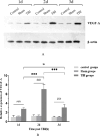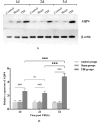Experimental study of cerebral edema and expression of VEGF and AQP4 in the penumbra area of rat brain trauma
- PMID: 40379765
- PMCID: PMC12084337
- DOI: 10.1038/s41598-025-02071-2
Experimental study of cerebral edema and expression of VEGF and AQP4 in the penumbra area of rat brain trauma
Abstract
Traumatic brain injury (TBI) has a high disability rate and a high fatality rate. Traumatic penumbra (TP) is a potentially reversible area around the core area of brain trauma with cerebral edema as the main pathological change, which is a breakthrough to improve the prognosis of patients with TBI and reduce the mortality and disability rate of TBI. Unfortunately, the pathophysiological mechanism of TP is still not fully understood. In this study, we established a moderate traumatic brain injury model in rats and detected pathological molecular markers in TP. Protein content of IgG, VEGF, and AQP4 were detect respectively by HE, Immunofluorescence, and western blot. To investigate the time-varying characteristics of TP, to provide a reference for research and development and screening of TBI targeted drugs. Our experiment showed mainly intracellular edema and vascular edema in TP, first intracellular then vascular edema was dominant. IgG, VEGF, and AQP4 in TP increased significantly. On the second day, AQP4 decreased, and third day AQP4 increased again. We found that in the early stage of TBI cerebral edema developed and it is related to the increase of BBB permeability, upregulation of VEGF and AQP4. Suggesting potential targets for treatment of TP.
Keywords: AQP4; BBB; Cerebral edema; Traumatic penumbra; VEGF.
© 2025. The Author(s).
Conflict of interest statement
Declarations. Competing interests: The authors declare no competing interests. Institutional review board statement: All animal experiments were reviewed and approved by the Institutional Animal Care and Committee of The Seventh People’s Hospital of Chongqing (approval number 479/ March 19,2020). All the experiments were carried out in the army special occupational disease prevention and Control Laboratory of Field Surgery Research Department, Army Characteristic Medical Center, Army Medical University. All experimental animals were treated in accordance with GB/T 35892 − 2018 Guidelines for ethical review of the welfare of experimental animals and guidelines for the management and use of experimental animals (8th edition).
Figures






Similar articles
-
Effect of Bevacizumab on traumatic penumbra brain edema in rats at different time points.Tissue Barriers. 2024 Oct;12(4):2292463. doi: 10.1080/21688370.2023.2292463. Epub 2023 Dec 12. Tissue Barriers. 2024. PMID: 38084736 Free PMC article.
-
Inhibition of HIF-1α-AQP4 axis ameliorates brain edema and neurological functional deficits in a rat controlled cortical injury (CCI) model.Sci Rep. 2022 Feb 17;12(1):2701. doi: 10.1038/s41598-022-06773-9. Sci Rep. 2022. PMID: 35177771 Free PMC article.
-
Relationship between AQP4 expression and structural damage to the blood-brain barrier at early stages of traumatic brain injury in rats.Chin Med J (Engl). 2013 Nov;126(22):4316-21. Chin Med J (Engl). 2013. PMID: 24238521
-
Aquaporin 4 in Traumatic Brain Injury: From Molecular Pathways to Therapeutic Target.Neurochem Res. 2022 Apr;47(4):860-871. doi: 10.1007/s11064-021-03512-w. Epub 2022 Jan 28. Neurochem Res. 2022. PMID: 35088218 Review.
-
Traumatic Brain Injury and Blood-Brain Barrier (BBB): Underlying Pathophysiological Mechanisms and the Influence of Cigarette Smoking as a Premorbid Condition.Int J Mol Sci. 2020 Apr 14;21(8):2721. doi: 10.3390/ijms21082721. Int J Mol Sci. 2020. PMID: 32295258 Free PMC article. Review.
References
-
- Wang, H. et al. TMT-based proteomics analysis to screen potential biomarkers of acute-phase TBI in rats. Life Sci.264, 118631 (2021). - PubMed
-
- van Gils, A. et al. Management of mild traumatic brain injury. Pract. Neurol.20 (3), 213–221 (2020). - PubMed
-
- Pitkänen, A. et al. Posttraumatic epilepsy - disease or comorbidity? Epilepsy Behav.38, 19–24 (2014). - PubMed
-
- Dewan, M. C. et al. Estimating the global incidence of traumatic brain injury. J. Neurosurg.130 (4), 1080–1097 (2018). - PubMed
-
- Lu, C. et al. Advances in diagnosis, treatments, and molecular mechanistic studies of traumatic brain injury. Biosci. Trends. 9 (3), 138–148 (2015). - PubMed
MeSH terms
Substances
Grants and funding
LinkOut - more resources
Full Text Sources
Medical

